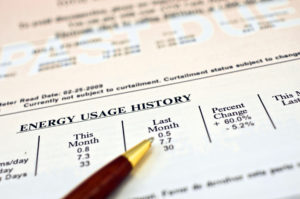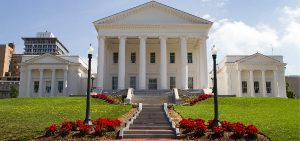Leading By Example Through Building Performance
 The VAEEC recently hosted a webinar on building performance primarily for local governments across the Commonwealth. Leading By Example Through Building Performance followed three different building performance policies and programs to not only encourage the audience to implement their own strong green building policy but to also provide best practices and lessons learned from the design phase all through the day-to-day management of a program.
The VAEEC recently hosted a webinar on building performance primarily for local governments across the Commonwealth. Leading By Example Through Building Performance followed three different building performance policies and programs to not only encourage the audience to implement their own strong green building policy but to also provide best practices and lessons learned from the design phase all through the day-to-day management of a program.
Speakers included:
- Dawn Oleksy, Climate Action Programs & Operations Supervisor, City of Richmond
- Bill Eger, Energy Manager, City of Alexandria
- Holly Savoia, Director of Sustainability Enforcement, NYC Department of Buildings, and
- Elizabeth Beardsley, Senior Policy Counsel, U.S. Green Building Council.
With Virginia being a Dillon Rule state, localities are limited as to what they can and cannot mandate. However, jurisdictions are finding ways to make progress happen in their communities.
The webinar began with an overview of green buildings and the benefits of a strong green building policy – such as energy savings, emission reductions, and improved air quality – from Liz. Next, Dawn covered the City of Richmond’s climate action policy, RVAgreen 2050, which the City is currently in the middle of developing. RVAgreen 2050 centers around three key points: equity, climate action, and climate resilience. Buildings & Energy is one of five pathways the City is using to meet its goal of achieving net-zero emissions by 2050 and becoming more climate-resilient. This includes requiring an equitable building performance policy for existing commercial buildings, retro-commissioning for existing commercial buildings to improve efficiency, and benchmarking existing commercial buildings.
RVAgreen 2050 is equitable climate action for a healthy and resilient Richmond.
Dawn specified the need for stakeholder engagement throughout the entire process in order to better understand the community’s priorities. She also shared RVAgreen 2050’s measuring process to track the plan’s outcomes and the shared accountability framework to encourage transparency, a culture of improvement, trusting relationships, institutionalizing sustainability in city government, and regular evaluation.
Richmond just began the next phase of community-wide engagement to gather feedback on the plan. RVAgreen 2050 is scheduled to be finalized this summer and adopted by fall.
Next, Bill provided an overview of the City of Alexandria’s Green Building Policy. The City initially enacted this policy in 2009. Alexandria created the Environmental Action Plan 2040 to support the City’s goals, which include climate action and energy reduction.
The Green Building Policy establishes minimum green building practices for new public and private development and major renovations.
To work around Virginia’s “constrained policy environment”, authority for this policy is rooted in the City’s zoning code. Certain building performance conditions are required for the Development Site Plan and Development Special Use Permit review processes. New development must achieve the LEED Silver level of certification at a minimum. Using a third-party rating system provides an expert verification of meeting compliance requirements without having to have experts on staff. The policy also includes a minimum threshold requirement for a number of community priorities, such as energy efficiency, renewable energy, and advanced energy metering.
The Green Building Policy was updated in 2019 to include newer concepts such as decarbonization. In the ten-year span between 2009 and 2019, over 95% of the development square footage constructed or currently under construction in Alexandria is compliant with the 2009 policy. This equates to nearly 10 million square feet of green building development.
Holly provided an overview of New York City’s Energy Grades Program, including the local sustainability laws that led to this program. PlaNYC set out to reduce the City’s emissions by 30% by 2030. The Greener, Greater Buildings Plan paved the way for benchmarking, energy audits and retro-commissioning, and lighting upgrades and sub-metering. Then, after Hurricane Sandy hit, the One City Built to Last Policy increased the emissions reduction goal to 40% by 2030 and 80% by 2050.
Commercial benchmarking served as the precursor to the City’s Energy Grades Program.
Since it provides transparency of a property’s annual energy and water usage, benchmarking is seen as the first step for building owners or tenants to make a building more efficient – you can’t change what you can’t measure.
The City’s commercial benchmarking mandate originally applied to buildings over 50,000 SF, but was later amended to apply to any building over 25,000 SF. Building owners must report their building’s energy and water consumption annually through the U.S. EPA’s Energy Star Portfolio Manager. Portfolio Manager is a readily accessible, free tool, so the municipality did not have to purchase it or develop their own benchmarking software. Additionally, building owners do not have to pay to use it or hire someone else to input the data, which helps lead to higher compliance rates. New York City has also created a way for building owners to automatically upload their data from their utility bills. Initially, violation fees were issued once a year. Now that they are issued on a quarterly basis, the City has a 96% compliance rate.
New York City’s Building Energy Grades Program applies to most buildings over 25,000 SF. The Department of Buildings uses a building’s benchmarking data to assign qualified buildings a letter grade distribution based on their Energy Star score. Owners are required to post their building’s Energy Efficiency Rating Label in a conspicuous location of their building’s entrance. The program provides transparency of a property’s energy efficiency to the public.
One of the key takeaways from all the speakers is the importance of getting the private sector involved early in the policy-making process. Getting them involved from the beginning not only increases buy-in but also allows localities to understand challenges that they may not have foreseen and to brainstorm solutions.
It was inspiring to see all of the thought and effort that goes into developing, implementing, and managing green building policies.
A recording of the webinar can be viewed here. Contact info@vaeec.org for more information.

 2020 legislation mandated the benchmarking of Virginia’s public buildings, which is no small task. There are 10,888 buildings with 117 million square feet of space in the state’s building asset portfolio. In an effort to “lead by example”, the state energy office has developed an energy data warehouse to track and manage this building data. Using energy management dashboards, they are able to highlight energy conservation champions and benchmarking best practices. By pin-pointing areas needing efficiency measures, staff is able to offer support to get innovative technologies implemented, which then help the Commonwealth achieve its energy efficiency goals. Additionally, the state energy office is willing to help interested localities by sharing their energy tracking software.
2020 legislation mandated the benchmarking of Virginia’s public buildings, which is no small task. There are 10,888 buildings with 117 million square feet of space in the state’s building asset portfolio. In an effort to “lead by example”, the state energy office has developed an energy data warehouse to track and manage this building data. Using energy management dashboards, they are able to highlight energy conservation champions and benchmarking best practices. By pin-pointing areas needing efficiency measures, staff is able to offer support to get innovative technologies implemented, which then help the Commonwealth achieve its energy efficiency goals. Additionally, the state energy office is willing to help interested localities by sharing their energy tracking software.  Beyond Virginia, cities and counties across the country mandate benchmarking for commercial and public buildings. Just to our north, the District of Columbia passed legislation in 2008 requiring all private buildings greater than 50k square feet and all public buildings greater than 10k square feet to report their annual energy and water use. This program is run through the D.C. Dept. of Energy & Environment (DOEE) in partnership with the D.C. Sustainable Energy Utility (DCSEU). All data is reported through the U.S. Environmental Protection Agency’s free ENERGY STAR Portfolio Manager. DOEE also uses the Standard Energy Efficiency Data (SEED) Program to centralize energy benchmarking data. SEED allows the DOEE to track compliance, enforcement, and communications with building owners and managers.
Beyond Virginia, cities and counties across the country mandate benchmarking for commercial and public buildings. Just to our north, the District of Columbia passed legislation in 2008 requiring all private buildings greater than 50k square feet and all public buildings greater than 10k square feet to report their annual energy and water use. This program is run through the D.C. Dept. of Energy & Environment (DOEE) in partnership with the D.C. Sustainable Energy Utility (DCSEU). All data is reported through the U.S. Environmental Protection Agency’s free ENERGY STAR Portfolio Manager. DOEE also uses the Standard Energy Efficiency Data (SEED) Program to centralize energy benchmarking data. SEED allows the DOEE to track compliance, enforcement, and communications with building owners and managers.  The Virginia Energy Efficiency Council is working with Del. Rip Sullivan on commercial benchmarking legislation for the 2022 General Assembly session. The legislation will allow localities to mandate commercial benchmarking programs within their jurisdiction. We hope to set up the legislation in a way that is beneficial to localities. Therefore, we are facilitating conversations with our local government members who are interested in this topic. We have also met with several benchmarking experts to glean their best practices. Stay tuned for more information, or contact
The Virginia Energy Efficiency Council is working with Del. Rip Sullivan on commercial benchmarking legislation for the 2022 General Assembly session. The legislation will allow localities to mandate commercial benchmarking programs within their jurisdiction. We hope to set up the legislation in a way that is beneficial to localities. Therefore, we are facilitating conversations with our local government members who are interested in this topic. We have also met with several benchmarking experts to glean their best practices. Stay tuned for more information, or contact